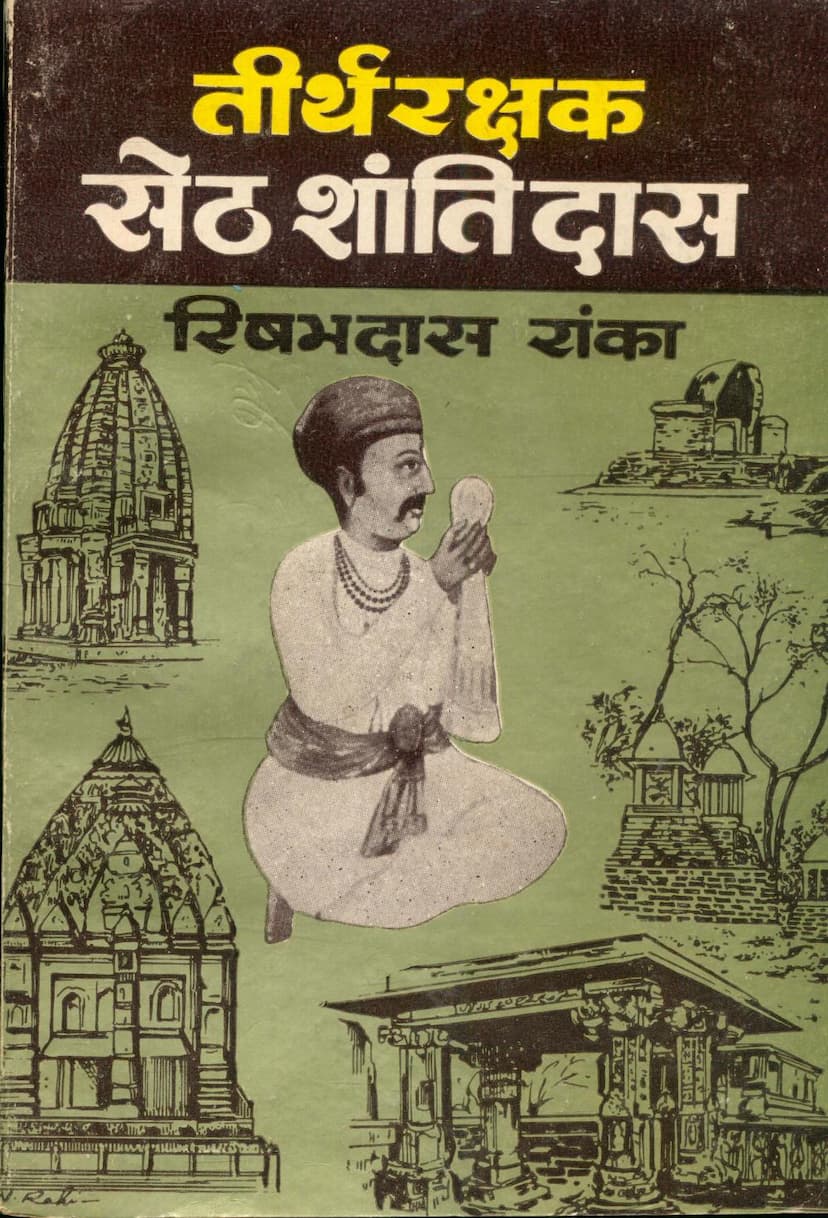Tirthrakshak Sheth Shantidas
Added to library: September 2, 2025

Summary
Here is a comprehensive summary in English of the Jain text "Tirthrakshak Sheth Shantidas":
This book, "Tirthrakshak Sheth Shantidas," authored by Rishabhdas Ranka and published by Ranka Charitable Trust, is presented as a humble tribute to the author's earlier, unpublished work. The book aims to highlight the significant, yet often overlooked, contributions of Jains to Indian society, governance, and religious traditions. It critiques the historical neglect of Jain contributions, sometimes attributed to Jainism being considered a "nāstik" (atheistic) religion, and also points to internal divisions within the Jain community that hindered mutual appreciation of literary and historical achievements.
The book uses the life of Sheth Shantidas Johari as a lens to illuminate historical episodes and the influence of Jains during his era. It emphasizes that Jainism's influence predates the common era, citing figures like Parshvanath and Mahavir. The text points to the influence of Jains on Hindu rulers and Muslim emperors, highlighting instances where rulers issued decrees influenced by Jain principles of ahimsa (non-violence).
A significant portion of the book focuses on the life and accomplishments of Sheth Shantidas.
Early Life and Career:
- Shantidas's grandfather, Sahasrakiran, a Rajput of the Sisodia lineage, was forced to leave his ancestral lands in Mewar due to Muslim invasions. He migrated to Ahmedabad and found employment with a Marwari jeweler. Sahasrakiran's diligence and sharp intellect impressed the jeweler, who eventually gave him his daughter and business in marriage.
- Sahasrakiran's son, Vardhaman, was born from his first marriage, and Shantidas was born from his second marriage. Vardhaman managed the Ahmedabad business while Shantidas traveled extensively for trade, sourcing pearls from Sri Lanka, rubies from Burma, and diamonds from Golconda. He conducted business with kings, nawabs, and emperors, earning a reputation for his peaceful nature, sweet speech, integrity, and generosity.
- Shantidas was deeply religious, adhering to Jain vows and never consuming food or water without first having dev-darshan (seeing the deity/temple).
Rise to Prominence and Influence with the Mughals:
- Shantidas gained recognition at Emperor Akbar's court when he accurately appraised a valuable diamond using an ancient Jain text on gemology. Akbar was so impressed that he appointed Shantidas as the imperial jeweler and presented him with a Kashmiri shawl.
- Shantidas's integrity and good behavior fostered trust, allowing him access to the royal zenana (harem) for jewelry consultations. He also developed a close relationship with Emperor Jahangir and his consort, Jodha Bai.
- When Jodha Bai, estranged from Akbar, fled to Ahmedabad, Shantidas was entrusted with her care and hospitality, demonstrating his influence and trustworthiness. This act also led to an unusual familial bond where Jodha Bai tied a rakhi on Shantidas, making him her brother. This elevated his status in the eyes of the royal family.
Challenges and Resilience:
- Shantidas faced a significant challenge when Aurangzeb, known for his intolerance, became the Subedar of Gujarat. Aurangzeb, despite his father Jahangir's permission for the construction of a grand Jain temple (later named 'Merutunga' and consecrated with the idol of Chintamani Parshvanath), had it converted into a mosque.
- Despite his initial distress and undertaking a rigorous vow of ayambill (a type of fasting), Shantidas, through astute political maneuvering and leveraging his long-standing relationship with the Mughal dynasty, secured a royal decree from Shah Shuja (who had replaced Aurangzeb) to reclaim the property. However, due to societal rigidity and the mosque's existing structure, the temple could not be rebuilt in its original form, leaving the valuable structure as ruins. This event highlights both Shantidas's remarkable efforts and the societal limitations he faced.
Role as a Guardian of Jain Tirths (Holy Places):
- Beyond his business dealings, Shantidas was deeply involved in the management and protection of Jain holy places like Shatrunjaya (Palitana), Shankheshwar, and Keshariyaji. He obtained royal decrees from Mughal emperors to ensure their safety and prevent interference.
- He financed the construction of upashrayas (monasteries) in various cities and actively participated in religious festivals. He also managed public institutions like panjrapoles (animal shelters).
Legacy and Descendants:
- The book then details the lives of Shantidas's descendants, including his son Sheth Laxmichand, grandson Sheth Khushalchand, and great-grandson Sheth Bakhatshah. They continued the family's tradition of wealth, piety, and public service.
- Sheth Laxmichand played a crucial role during the succession struggles after Shah Jahan, providing financial and logistical support to various claimants, notably Murad Bakhsh and later Bahadur Shah. He also secured important royal firmans (decrees) for the protection of Jain tirths.
- Sheth Khushalchand demonstrated immense courage and defiance against a proud Subedar by refusing to seek permission for a religious procession, asserting the inherent right of his community. He also skillfully navigated the turbulent political landscape between the Mughals and Marathas, even dissuading them from looting Ahmedabad.
- Sheth Bakhatshah managed the complex transition of power between the Mughals, Marathas, and the rising British influence, maintaining the family's financial and social standing.
- Sheth Hemabhai continued the family's legacy, managing vast businesses and contributing to religious and social causes.
- Sheth Lalbhai (grandfather of Kasturbhai Lalbhai) was a visionary industrialist who embraced the textile industry, laying the foundation for the vast industrial empire that followed. He also served as the president of the Anandji Kalyanji Pedhi, actively protecting Jain tirths and promoting education. His efforts to prevent the archaeological department from taking over the Jain temples at Mount Abu are highlighted as a significant act of courage.
The book emphasizes that Sheth Shantidas and his descendants were not just wealthy merchants but also devout Jains, astute politicians, and dedicated patrons of their faith and community, playing a vital role in safeguarding Jain heritage during tumultuous historical periods. The narrative underscores their business acumen, political influence, unwavering faith, and commitment to societal welfare.